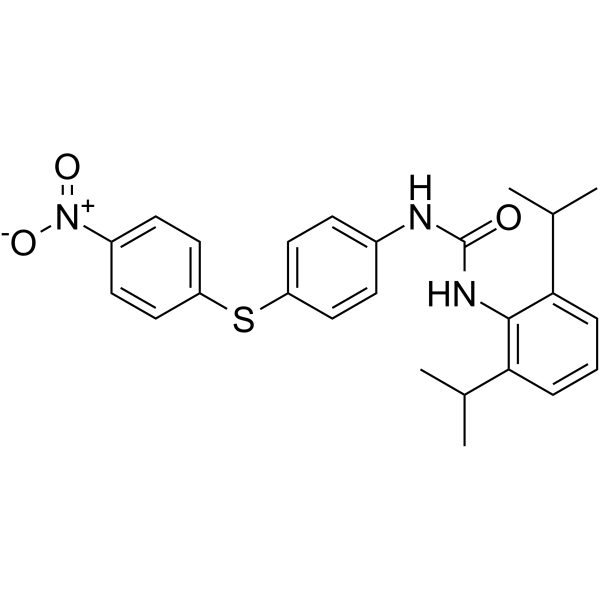
VULM 1457
CAS No. 228544-65-8
VULM 1457( —— )
Catalog No. M27737 CAS No. 228544-65-8
VULM 1457 is a potent ACAT inhibitor. VULM 1457 has remarkable hypolipidaemic activity and improves the overall myocardial ischaemia-reperfusion injury outcomes.
Purity : >98% (HPLC)
 COA
COA
 Datasheet
Datasheet
 HNMR
HNMR
 HPLC
HPLC
 MSDS
MSDS
 Handing Instructions
Handing Instructions
| Size | Price / USD | Stock | Quantity |
| 2MG | 61 | Get Quote |


|
| 5MG | 87 | Get Quote |


|
| 10MG | 147 | Get Quote |


|
| 25MG | 287 | Get Quote |


|
| 50MG | 520 | Get Quote |


|
| 100MG | 750 | Get Quote |


|
| 500MG | 1521 | Get Quote |


|
| 1G | Get Quote | Get Quote |


|
Biological Information
-
Product NameVULM 1457
-
NoteResearch use only, not for human use.
-
Brief DescriptionVULM 1457 is a potent ACAT inhibitor. VULM 1457 has remarkable hypolipidaemic activity and improves the overall myocardial ischaemia-reperfusion injury outcomes.
-
DescriptionVULM 1457 is a potent ACAT inhibitor. VULM 1457 has remarkable hypolipidaemic activity and improves the overall myocardial ischaemia-reperfusion injury outcomes. VULM1457 significantly reduces production and secretion of adrenomedullin (AM) and down-regulates AM receptors on human hepatoblastic cells.(In Vitro):Preincubation of HepG2 cells with VULM1457 (0.1 μM) significantly reduced the specific [125I]AM binding on hypoxic cells with BmaxHypox being 127±10 and KD 0.06±0.11 nM. Preincubation of cells with VULM1457 (0.1 μM) significantly enhanced the number of cells (24.2±6 %) and higher concentrations of VULM1457 (1.0 and 10.0 μM) reduces the total number of cells. In HepG2 cell lines, VULM1457 (0.03 μM; 0.1 μM) significantly down-regulated specific AM receptors on HepG2 cells, and reduced AM secretion of HepG2 cells exposed to hypoxia. VULM1457 negatively regulates cell proliferation induced by AM.(In Vivo):In male Wistar rats, VULM 1457 protected the hearts of diabetic–hypercholesterolaemic rats against ischemia/reperfusion injury in vivo. VULM 1457 (50 mg/kg/day) significantly decreases plasma total cholesterol levels (1.7±0.1 mM vs. 2.9±0.5 mM in diabetic–hypercholesterolaemic animals). The hypolipidaemic effect of VULM 1457 is also observed in the liver of DM-HCH rats (3.9±0.2 mg/g vs. 7.4±1.0 mg/g).
-
In VitroVULM1457 (0.03 and 0.1 μM) significantly down-regulates specific AM receptors on HepG2 cells, reduced AM secretion of HepG2 cells exposed to hypoxia.VULM1457 negatively regulates cell proliferation induced by AM.Preincubation of HepG2 cells with VULM1457 (0.1 μM) significantly reduces the total number of specific [125I]AM binding identified on cells at untouched affinity. Preincubation of HepG2 cells with high concentrations of VULM1457 (1.0 and 10.0 μM) significantly modifies the characteristics of binding of AM, i.e.Preincubation of HepG2 cells with VULM1457 (0.1 μM) significantly reduces the specific [125I]AM binding on hypoxic cells with BmaxHypox being 127±10 and KD 0.06±0.11 nM. Preincubation of cells with VULM1457 (0.1 μM) significantly enhances the number of cells (24.2±6 %) and higher concentrations of VULM1457 (1.0 and 10.0 μM) reduces the total number of cells. With the high concentrations of VULM1457 (1.0 and 10.0 μM), the reductions in [125I]AM specific binding on HepG2 cells is markedly attenuated.
-
In VivoVULM 1457 significantly reduces atherogenic activity in animal experimental atherosclerosis.VULM 1457 protect the hearts of diabetic–hypercholesterolaemic rats against ischaemia/reperfusion injury in vivo.VULM 1457 (50 mg/kg/day; administered as an admixture to the fat-cholesterol diet for 5 days) significantly decreases plasma total cholesterol levels (1.7±0.1 mM vs. 2.9±0.5 mM in diabetic–hypercholesterolaemic animals). The hypolipidaemic effect of VULM 1457 is also observed in the liver of DM-HCH rats (3.9±0.2 mg/g vs. 7.4±1.0 mg/g). Animal Model:Male Wistar rats (250-300 g body weight), fed a standard diet and tap water ad libitum Dosage:50 mg/kg/day Administration:Administered as an admixture to the fat-cholesterol diet for 5 days Result:Improved the overall myocardial ischaemia-reperfusion injury outcomes in the diabetic-hypercholesterolaemic rats by suppressing arrhythmogenesis as well as by reducing myocardial necrosis, aside from remarkable hypolipidaemic activity.
-
Synonyms——
-
PathwayOthers
-
TargetOther Targets
-
Recptor——
-
Research Area——
-
Indication——
Chemical Information
-
CAS Number228544-65-8
-
Formula Weight449.57
-
Molecular FormulaC25H27N3O3S
-
Purity>98% (HPLC)
-
SolubilityIn Vitro:?DMSO : 250 mg/mL (556.09 mM)
-
SMILESCC(C)c1cccc(C(C)C)c1NC(=O)Nc1ccc(Sc2ccc(cc2)[N+]([O-])=O)cc1
-
Chemical Name——
Shipping & Storage Information
-
Storage(-20℃)
-
ShippingWith Ice Pack
-
Stability≥ 2 years
Reference
1.C K Wilkins, et al. Volatile metabolites of some barley storage molds. Int J Food Microbiol. 1989 Feb;8(1):11-7.
molnova catalog



related products
-
(Rac)-BRD0705
(Rac)-BRD0705 is a less active racemate of BRD0705. BRD0705 is an effective and selective inhibitor of GSK3α.
-
Dipetalolactone
The herbs of Zanthoxylum dipetalum.
-
Decyl aldehyde
Decyl aldehyde is a natural organic compound.



 Cart
Cart
 sales@molnova.com
sales@molnova.com


